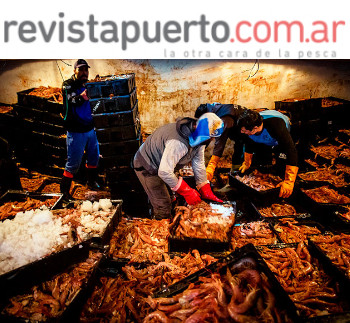|

Image: Revista Puerto / FIS
The Shrimp Season Begins with Excellent Yields
 ARGENTINA
ARGENTINA
Thursday, May 30, 2024, 01:00 (GMT + 9)
The results obtained in the prospecting left no doubts about the start of the harvest. With an average of 15 to 20 tons per day of a large, clean hake shrimp, four sub-areas are now available for the entire fleet. Observer coverage in the fresh fishing fleet must be improved.
The images that circulated on social networks of the boats that participated in shrimp prospecting are very eloquent. The bags rise full and absolutely orange given the scarce presence of hake. The prospected subareas were 4 and 5, located between the parallels of 42º and 43º South and those between the meridians of 60º and 62º West; and subareas 13 and 14 located between the parallels of 45º and 46º South between the meridians of 62º and 64º West. Given the good yields with low levels of bycatch, last night the Undersecretary of Fisheries notified the Prefecture that the four subareas were open to fishing as of 7:00 today, May 29.

Source: Revista Puerto
The average yields recorded for all fleets are between 15 and 20 tons per day depending on the subarea prospected; and the catches were composed of large specimens. The largest sizes and the best yields occurred in the subareas located to the north (4 and 5), especially in subarea 5, where the catches were composed mainly of L1; while in subarea 4 the composition was distributed almost equally between L1 and L2.
The abundance of L1 is good news for companies that have recently found demand for this product, while for the smaller sizes there were not even inquiries, since buyers are still in stock.
In the subareas prospected to the south, 13 and 14, the yields were also good but of lower volume, with mostly L1 specimens also found in subarea 14.
With these results, it was not necessary to wait for the publication of the minutes of the Federal Fisheries Council to begin the shrimp harvest and yesterday the note was issued to the Prefecture to enable the entry of the tangon fleet.
.png) Source: Stockfile FIS --> Source: Stockfile FIS -->
What we will have to wait for is the publication of the minutes, is to find out if any urgent discussions took place. One of the issues to be discussed is the request to modify the tide time of the freshwater fleet established at 72 hours from departure to arrival at port, which they intend to bring to 72 effective hours of fishing.
“The real consequence of this limit is to prevent three days of captures from being completed, which destroys business for shipowners and their companies by strongly restricting the entry of raw materials,” said CAPEAR.ALFA, the chamber that brings together the fresh produce, considering the argument of “taking care of quality” for which it has been imposed weak.
Other issues related to the fleet's operations for which CAPEAR-ALFA has requested a review are the trawling speed and the accepted navigation knot limit at night.
The freezing vessels' request to modify the limit of colas that can be processed on board will also be discussed, which is established at 30% and is intended to be raised to 50% in order to expand marketing possibilities, after going through several years of decline in the demand and price of frozen whole shrimp.
Another key issue to resolve is the boarding of observers on board in the fresh fleet, which is very low compared to the freezing fleet. Adding more observers would allow researchers to have better coverage of the distribution of the resource and respond to the requirements of the freshers during the season, which often find concentrations that cannot be corroborated to enable new fishing areas.
 <-- Source: CAPEAR AlFA <-- Source: CAPEAR AlFA
The boarding of observers in the freshwater fleet is an issue that requires the collaboration of all parties to be implemented. A more rigid position from the enforcement authority for shipowners to board and for observers to accept boarding even though conditions are not always as good as in the freezers.
It is also necessary to resolve logistical issues related to the entry of ships into port and the availability of observers, which should be scheduled before arrival so that the good predisposition of the fresh ship owners is reflected in the boarding of these assistants.
Without resource problems, there is room to advance on issues that make the best use in conditions of sustainability and aiming to achieve a product of excellence. This abundance scenario could be complicated if climate conditions become adverse, as happened in 2023, so it is important not to waste time finding solutions.
Author: Karina Fernández | Revista Puerto (Translated from the original in Spanish)
.png)
editorial@seafood.media
www.seafood.media
|



